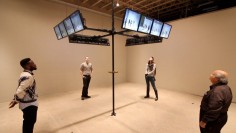James Coupe
Swarm

source: jamescoupe
Swarm takes the logic of social media – demographically organized communities based around common interests, habits and markets – and transposes it onto gallery audiences. Using four rows of monitors, the work generates competing panoramic representations of the gallery space that appear to be exclusively occupied by specific groupings of people – men in their 20s, women in their 50s, people of Asian descent, people dressed in black, men with beards. Each group is shown as what appears to be a live video image, with people inserted into a ‘crowd’ alongside others who have previously visited the gallery. Some crowds are much larger than others – a large group of middle-aged white women on one panorama, standing around, waiting for something to happen, may juxtapose with a solitary Latino male on another. Different demographic groupings territorialize the gallery’s spaces, their numbers dynamically expanding and contracting.
Swarm is inspired by J.G. Ballard’s High Rise (1975), a novel in which a thousand people live in close proximity in a modern apartment building. Eventually, the pressures of isolated yet claustrophobic living causes the residents of the high-rise to form clans, organized around class demographics. The situation rapidly becomes monstrous, as residents begin killing each other in order to assert control of their environments. For Ballard, the residents are cool, unemotional, desensitized, with minimal need for privacy and capable of thriving within the closed environment of this “malevolent zoo”:
[The residents had] no qualms about the invasion of their privacy by government agencies and data-processing organizations, and if anything welcomed these invisible intrusions, using them for their own purposes. These people were the first to master a new kind of late-twentieth century life. They thrived on the rapid turnover of acquaintances, the lack of involvement with others, and the total self-sufficiency of lives which, needing nothing, were never disappointed.
Ballard’s description of the paradoxical conditions of isolation and proximity in High Rise is analogous to the effects of twenty-first-century Social Media. Virtual environments like Facebook have successfully colonized our social existences, in part because of their efficiency and viral expansion into our daily lives. Users are willing to offer up their privacy to social media systems because they simplify the individual management of our social lives. In return, we are confronted with systems that take control over who we know, what we know about them and how those relationships are framed, remembered, and proceed. Social media technologies involve a redistribution of identities based upon principles of demographic segmentation, social exclusivity, and the illusion of community. Just as in Swarm and High-Rise, the collision of individual and masses involves a psycho-pathological breakdown, re-mapped by technology.
Credits: Programming: Yi Ding; Fabrication: Tivon Rice
With special thanks to John Robinson, University of York
Technical: Swarm uses four stereo cameras and computer vision algorithms to profile people in the gallery, calculate their location and add them to a database. The video panoramas are made by analyzing the database and selecting specific groupings of people. Crowds are composited by calculating the relative positions of people in each group and displaying as many as possible without occlusion. The groupings are selected dynamically – typically one screen always shows the majority demographic, one the minority, another the same group as a person in the gallery, with the other panorama rotating between various dynamically selected demographics.
.
.
.
.
.
.
.
source: jamescoupe
Born 1975, Blackpool, UK
Lives Seattle, USA + London, UK
“In his recent work, British-born, Seattle-based artist James Coupe examines the power and meaning of surveillance in our everyday life by working with advanced surveillance technologies, including high definition video cameras, facial recognition software, and computer algorithms derived from popular search engines and social media sites. Coupe works in new media but his artistic practice is anchored in an engagement with older media– namely, cinema, literature, and, most recently, the panorama. Situated at the intersection of the virtual, the fictional, and the real, Coupe’s work examines the ways that contemporary surveillance society simultaneously foregrounds self-observation and mutual observation, and thus mobilizes the classic scopophilic dialectic of voyeurism and exhibitionism. But, rather than subjecting surveillance to a systematic ideological critique, Coupe’s interests lie in the way surveillance provides a theme and metaphor for exploring the paradoxes of the postmodern human condition.”

